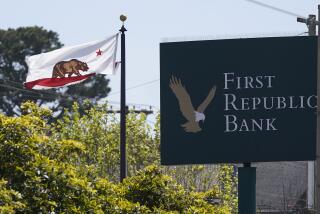Healthy Thrifts Didn’t Create Problem, and Shouldn’t Get the Bill
- Share via
One national survey has concluded that two-thirds of the American public opposes a federal bailout of the savings-and-loan industry. The choice of the word bailout , however, is a misnomer. The government isn’t about to bail out the S&L; industry. Nor should it. However, the federal government must keep its insurance guarantee to depositors with money in failed thrifts.
Taken at face value, the poll’s result is not surprising. I understand how people are disturbed by the notion that they should pay to cover losses that they had nothing to do with. But the pollsters were asking the wrong question.
Suppose that the question had been changed from “Do you favor a federal bailout of S&Ls;?” to “Should Americans who have deposited their hard-earned dollars into S&Ls; that later failed lose their money?” I think that we’d see a different answer from the respondents.
And that is precisely my point.
It is the depositors in failed thrifts who are being bailed out, not the S&L; industry. In fact, stockholders in failed thrifts have lost their equity investment. And that’s how it should be. Top management officials of those thrifts have lost their jobs. And that’s how it should be, too. In addition, where fraud existed, those responsible should spend timein a penitentiary.
Until now the healthy S&Ls; have been forced to bear the burden to prop up the ailing Federal Savings and Loan Insurance Corp. Four years ago the FSLIC began charg-ing them a second premium equal to one-eighth of 1% of deposits over and above the initial one-twelfth of 1% that all federally insured institutions pay for deposit insurance.
In fractions, that might not seem like much money. In real dollars, it’s a bundle. For instance, our institution, which has roughly $11 billion in deposits (the ninth-largest S&L; in California), paid about $23 million to the FSLIC in 1988. By contrast, similar-sized commercial banks paid a relatively tiny $9 million to the Federal Deposit Insurance Corp.
But that’s not the only difference. There are also higher interest rates that we pay to depositors for having that FSLIC sticker on our door instead of one signifying FDIC insurance.
For every $100 million in deposits, the average FSLIC-insured S&L; pays $300,000 more in interest costs than do typical FDIC-insured banks. In our case it meant that we paid $33 million more in interest on deposits than did a bank of the same size. And we incurred that cost despite being one of the nation’s healthiest financial firms--whether bank, S&L; or credit union.
Much has been written already about the causes of the nation’s thrift crisis. Suffice it to say that there is plenty of blame to go around. No one, however, suggests that the problem was created by the healthy savings-and-loans.
Nevertheless, it is the customers and shareholders of our institution and those of other healthy thrifts who are getting stuck with the bill for FSLIC’s insolvency. That inequity must stop.
Despite the industry’s special-assessment contributions, which have totaled more than $4.5 billion over four years, the FSLIC deficit has worsened precipitously. In fact, there is strong evidence that the special assessment is exacerbating the deficit by pushing hundreds of solvent thrifts into insolvency.
It has grown to the point where that $4.5 billion could not cover the annual interest costs of borrowing the $100 billion needed to either pay off depositors of insolvent thrifts or merge the deposits into healthy S&Ls.; Additional funds must come from other sources, including the U.S. Treasury.
So asking whether Americans favor or oppose an “S&L; bailout” is moot. The fact is that the government must keep its promise to insure accounts up to $100,000 per depositor.
Further delays in appropriating the funds will only intensify the problem. At its current rate of losing more than $30 million a day, the FSLIC will need an additional $7 billion even if the crisis were resolved by August (a long shot at best).
Several funding proposals have already been floated in Washington as trial balloons. More can be expected in the coming months before an agreement can be reached.
The Bush Administration has already taken a giant step in recognizing the severity of the problem and placing it near the top of its agenda of issues needing quick resolution. Now let’s get on with solving the problem in an equitable and timely fashion for the benefit of America’s taxpayers and our financial-services system.
More to Read
Inside the business of entertainment
The Wide Shot brings you news, analysis and insights on everything from streaming wars to production — and what it all means for the future.
You may occasionally receive promotional content from the Los Angeles Times.










